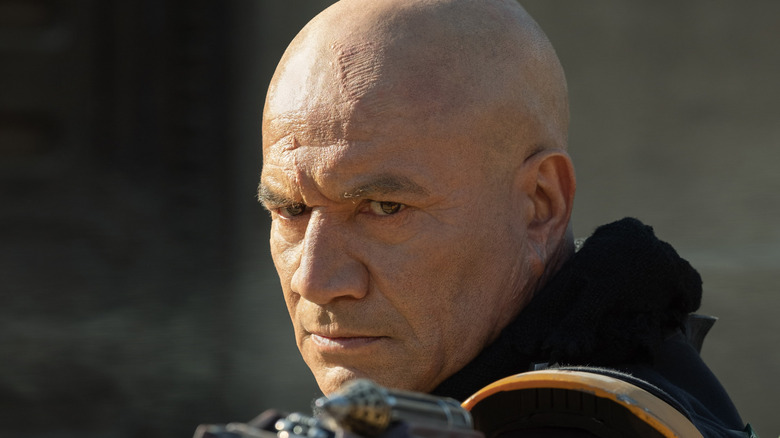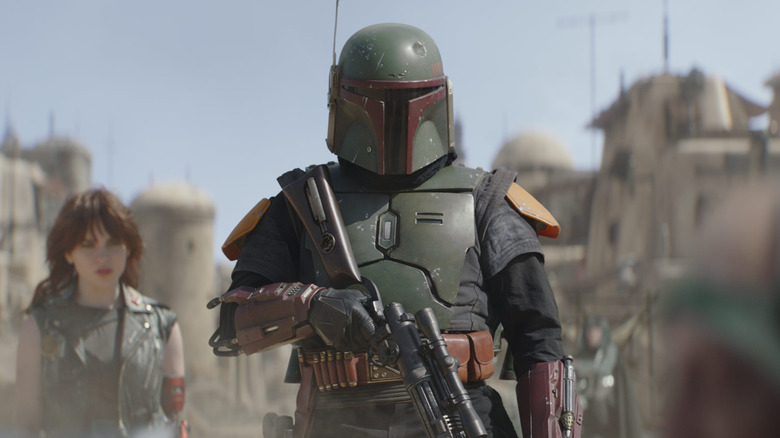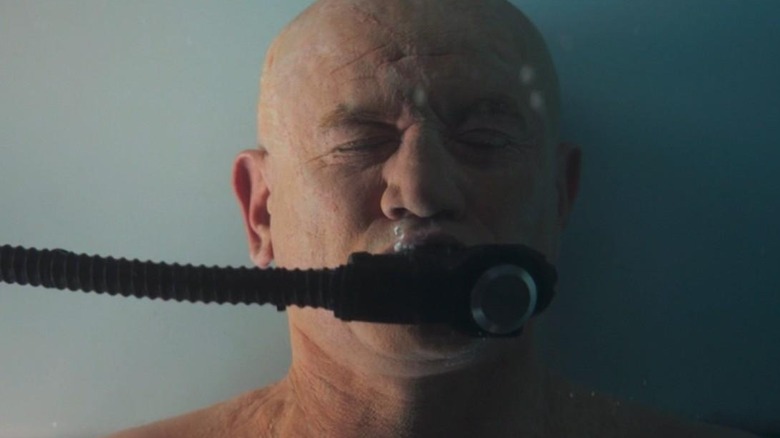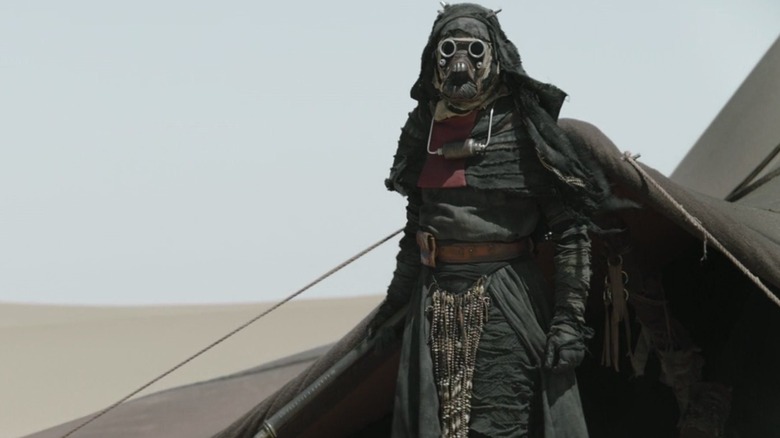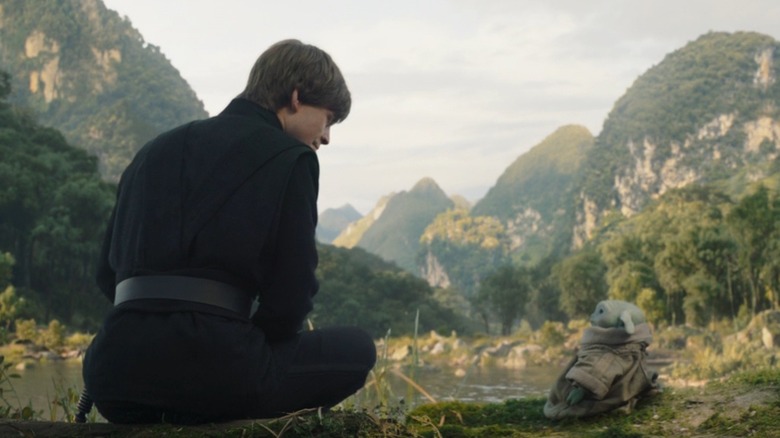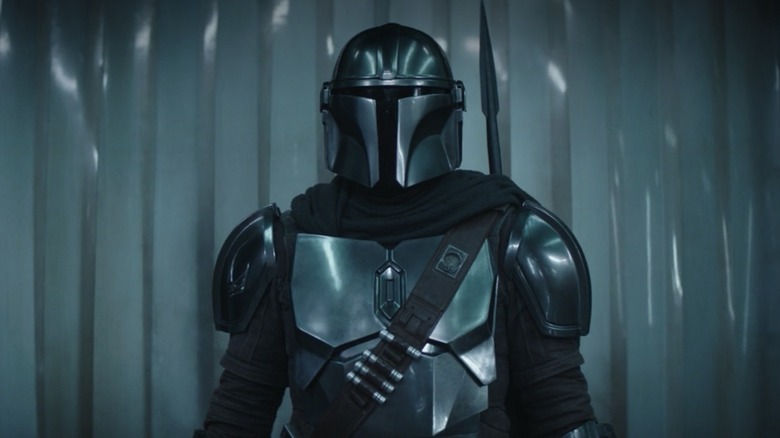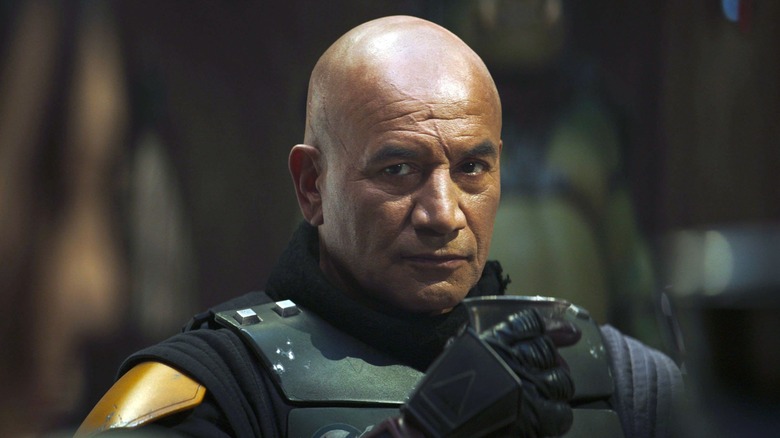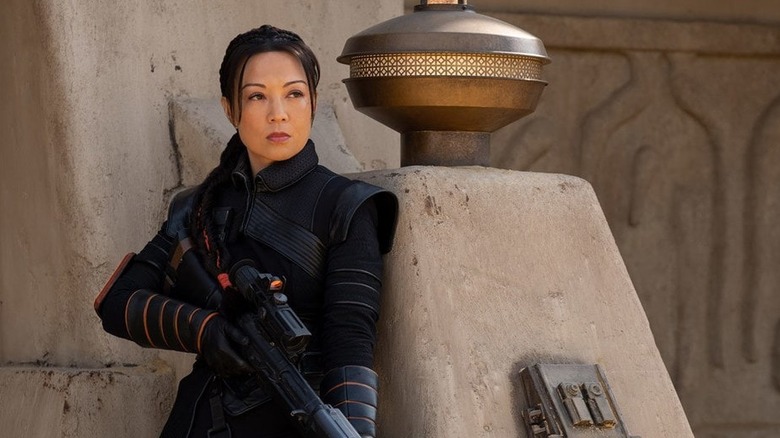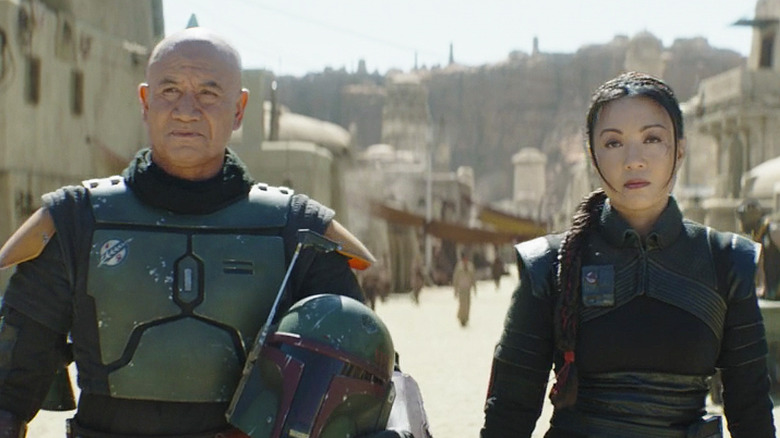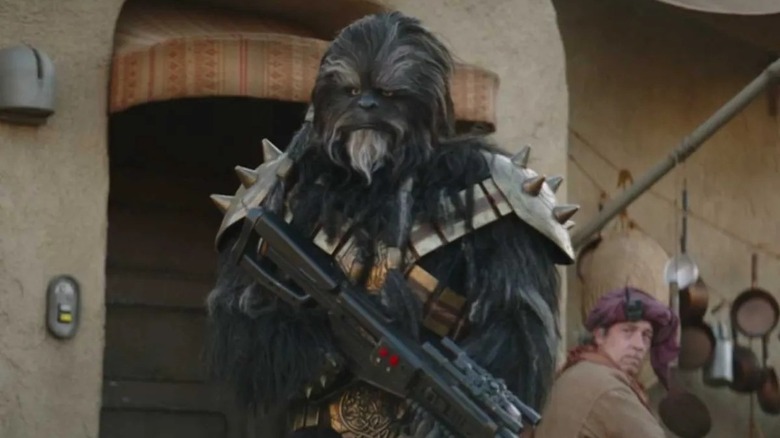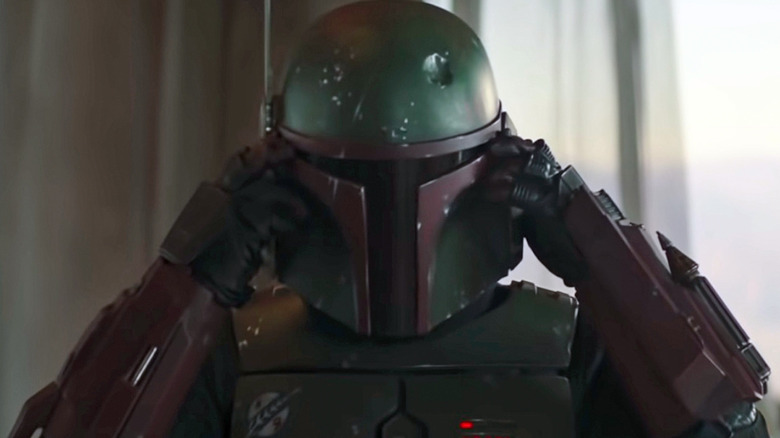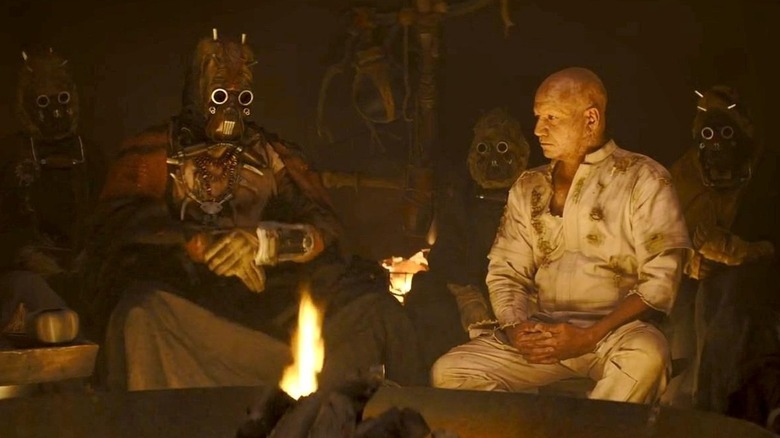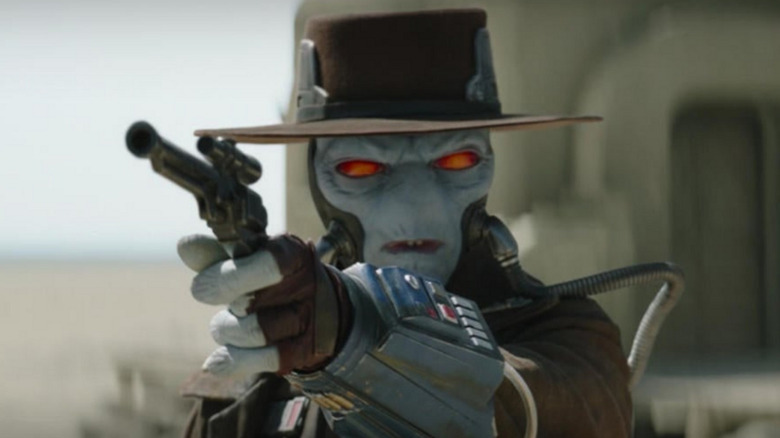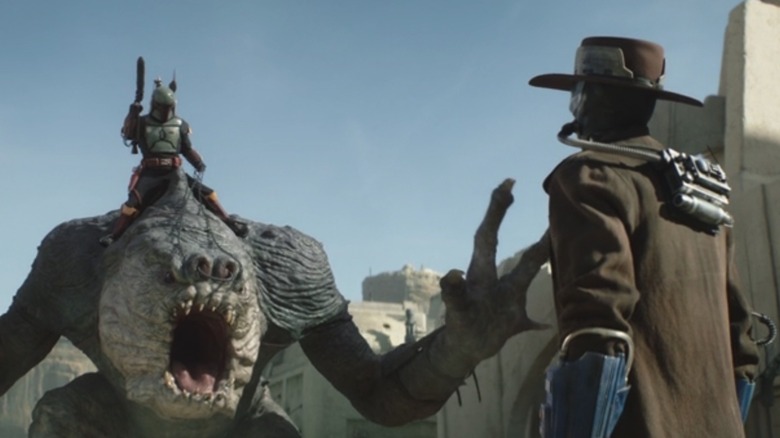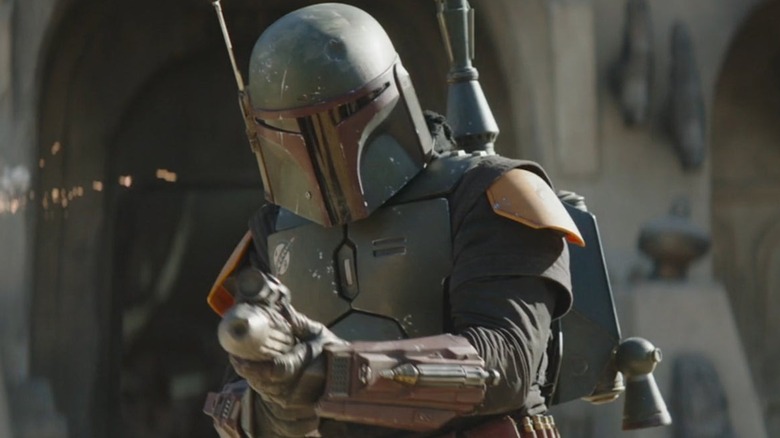The Best And Worst Things About The Book Of Boba Fett
The long-awaited "Book of Boba Fett" has come to an end, finally giving "Star Wars" fans a full story centered on the galaxy's most famous bounty hunter. When Temuera Morrison (who played Jango Fett in "Star Wars: Episode II — Attack of the Clones") returned as Boba in "The Mandalorian" Season 2, critics and fans celebrated (per CNET). It was a great new version of one of the franchise's most beloved characters, and when the season ended with a tease for Fett's own show on Disney+, expectations went high.
Unfortunately, "The Book of Boba Fett" doesn't quite live up to its full potential. Reviews have been positive overall, but with some caveats. Make no mistake — there's a lot to love about the series, from the commanding lead performances to the enrapturing look and feel of this latest iteration of Tatooine. But there are also a lot of disappointments. A show starring Boba Fett and Fennec Shand should have been a guaranteed home run, but even with "The Mandalorian" alums like Jon Favreau, Dave Filoni, and Robert Rodriguez leading the way, the story gets held back by a number of questionable and at times even baffling writing decisions.
There's an argument to be made that "The Mandalorian" is the best story "Star Wars" has produced in decades (via Forbes), so it's sad to see "The Book of Boba Fett" fall short of that high standard. But again, there's still a lot to like about it. Here are some of the best things about "The Book of Boba Fett," and some of the worst things holding it back from true greatness.
Best: Style
Let's start with something "The Book of Boba Fett" does exceptionally well — style. The whole series drips with it, from the commanding main musical theme by composer Ludwig Göransson to the dirty, Outer Rim aesthetic of Tatooine's Dune Sea and the streets of Mos Espa. Tatooine is debatably the most famous and important planet in the entire "Star Wars" universe (via CBR), and it's fun to see new details like the cybernetic mod scene and the political corruption of the planet's larger settlements be explored. After so many decades since Tatooine first appeared on screen, it's nice to know there's still more to discover here.
And of course, the show's stylish aesthetic extends to other aspects of the production, as well. Boba's bacta tank-induced flashbacks have a cool wilderness look and feel that separates them from most other "Star Wars" stories, and the whole show embraces its Western influences with lots of duels, shootouts, and roving gangs of bandits. If "The Mandalorian" is a Western, then "The Book of Boba Fett" is a true frontier show, just as interested in the absolute fringes of Tatooine society as it is with the larger urban centers.
"The Mandalorian" has won numerous Emmy Awards in categories like visual effects, cinematography, music, sound design, and makeup, and "The Book of Boba Fett" keeps that trend of greatness going across all stylistic fronts.
Worst: Repetition
The thing about style is that it's only as good as the story it's helping to tell, and the story that "The Book of Boba Fett" tries to tell is incredibly repetitive. From the start, the show seems determined to spend a majority of its time explaining things that are already pretty well understood. Yes, it's probably necessary to show how Boba escaped from the Sarlacc, but it's also a bit redundant.
That wouldn't be so bad if Boba's Tusken Raider flashbacks had more of an arc to them, but the show falls short in that department, as well. The new Tusken characters are cool and compelling, but they're never really made into full characters. By the same token, Fett doesn't really change much during his time with them. The series suggests that his near-death experience pushed him into a more compassionate mindset, but that shift isn't actually depicted, robbing the first half of the show of any real emotional development since most of the screen time is dedicated to his tenure with the Tuskens (via The Guardian).
The repetition extends to other aspects of the show, too. Tatooine is great, but when you're dealing with intergalactic crime syndicates, it might be a good idea to show some other planets. Boba's ship is one of the most iconic things about the character, and he barely even flies it in the show. More than anything, "The Book of Boba Fett" seems more interested in standing in one place than showing much real movement, and that's a shame.
Best: New Tusken Raider Lore
While the Tusken plotline certainly isn't everything it could have been, there's still a lot to like about it. Since the first "Star Wars" film, the Tuskens have embodied some highly problematic stereotypes of indigenous groups being "savages," but that narrative has been positively amended in "The Mandalorian" and "The Book of Boba Fett" (per Inverse). After barely escaping from the Sarlacc pit, Boba is captured by a Tusken tribe and put to work digging for water. After proving his mettle, however, he is accepted into the tribe, sent on a spiritual quest through the desert, and allowed to craft his own gaffi stick.
This portrayal of Tusken society is far more nuanced and interesting than how they've been shown in the past. The tribe has its own culture, religious customs, and political hierarchies, and while their environment necessitates some brutal behavior for survival, they're still shown to be people.
Viewers have still taken understandable issues with some aspects of the Tusken story in "The Book of Boba Fett" — particularly with how most of them are killed off halfway through the show (via IndieWire) — and these criticisms are entirely valid. But it's still worth acknowledging how "Star Wars" is working to undo some of its more problematic characterizations decades later.
Worst: Bad Pacing
The problems "The Book of Boba Fett" has with repetition go hand in hand with its pacing issues, which plague the show from start to finish. The core story is really pretty simple — Boba and Fennec take over the Mos Espa territory from Jabba's old henchmen, run into resistance when their arrival disrupts the operations of a major crime syndicate, and end up acting as the protectors of Mos Espa, a place that has never really had anyone stand up for it before. Boba Fett was one of the most notorious bounty hunters in the galaxy, meaning that he was a key part of the corruption and violence that forced the citizens of Tatooine to live in fear. The story of him reconciling with that history and choosing to become a better man to atone for his past should have been satisfying, but sadly, it barely even happened.
Half of the season is spent on storylines that have nothing to do with this main arc. The Tusken saga is interesting, but because Boba isn't given any real character development, it doesn't add much to the present-day story. The "Mandalorian" divergences are even more problematic, as they mainly serve to remind viewers that a much better "Star Wars" show exists (via Empire). Din gets more of an arc than Boba or Fennec, and he's only in a few episodes.
The result is that Boba's rise as Tatooine's savior becomes more of a subplot than the primary story it's supposed to be. The climax falls short as a result, leaving you wishing you could have just watched "The Mandalorian" Season 3 instead.
Best: The Mandalorian Returns
Despite the problems he causes in the show's pacing, it is good to see Din Djarin again in "The Book of Boba Fett." After four episodes of slow plodding and little emotional development, his appearance in Chapter 5 is a breath of fresh air. Immediately, the viewer is once again enraptured in Din's own story — how will he choose to use the Darksaber? What will it take for him to be accepted by his clan again after having removed his helmet? And will he ever be reunited with Baby Yoda? These are all exciting questions, and they lead to some fun underworld interactions, a visit to Luke Skywalker's new Jedi academy, a surprise cameo from Rosario Dawson's Ahsoka Tano, and yes, the triumphant return of Grogu. It's incredible how much emotion Pedro Pascal is able to pull out of a monotone man in a helmet, and watching Din in "The Book of Boba Fett" is as entrancing as ever as a result.
There are a lot of great individual moments here for fans of "The Mandalorian." Hearing Luke tell Grogu stories about Yoda; watching Din learn the ins and outs of wielding a lightsaber; discovering that Din's new ship will be a retrofitted Naboo starfighter from "The Phantom Menace; finally seeing the two embrace after such a long time apart. These are all fun developments, and they add a lot to "The Book of Boba Fett."
Worst: Boba Fett Takes A Backseat
Din Djarin and Grogu are great characters, but here's the problem: they have their own show. This show has a different character's name in the title, and he repeatedly gets shafted throughout "The Book of Boba Fett."
For the entire two episodes leading up to the finale, Boba Fett appears in a total of one scene, in which he barely speaks. This should be when emotional arcs are building to a climax — when he should be asking questions like, is this worth it? Am I really cut out to be the leader of a town like this? Or should I quit and go back to the old ways, traveling the galaxy alone in search of the next job? Instead, he gets completely sidelined while Din and Grogu go off down far more interesting storylines.
It's okay that "The Book of Boba Fett" shows a softer, kinder, more heroic version of its protagonist. It's not okay that his transformation goes wholly without analysis, reflection, or development. It's as if the writers were scared that giving Boba an arc would remove his cool factor, so instead, they just threw him into a totally different emotional space with no real buildup.
Lastly, the focus on Din and Grogu over Fett and Fennec may end up hurting "The Mandalorian" Season 3. "The Book of Boba Fett" wasn't marketed as necessary viewing for fans of its predecessor, but anyone who jumps to "Mando" Season 3 straight from Season 2 will be wildly confused.
Best: Fennec Shand Is Awesome
It's called "The Book of Boba Fett," but there's another clear star of the show here, and that's Ming-Na Wen's Fennec Shand. First introduced in "The Mandalorian" Season 1, Fennec has quickly become a "Star Wars" staple, with a recent cameo in "The Bad Batch" leading up to her live-action return.
Wen is a fantastic actor, and her performance as Fennec has been enthralling from the start. She exudes an almost overwhelming level of badass charisma, and it's always exciting to see her leaping across rooftops in pursuit of some foe whose fate is already sealed. Some particular highlights in "The Book of Boba Fett" are her speeder chase after Mos Espa's mayoral aide (David Pasquesi) and her brutal assassination of the mayor and his Pike Syndicate accomplices in the final episode.
Wen's onscreen chemistry with Temuera Morrison is also great. The scenes of them just adjusting to life as the bosses instead of the hired muscle they've always been are some of the best moments in the whole show, and "The Book of Boba Fett" could have benefitted from a lot more of them.
Worst: Fennec Shand Is Underused
The one thing Fennec has lacked so far is nuanced development. We know she's cool, but what makes her tick? What's her backstory? Why does she do what she does? These should have been easy questions for "The Book of Boba Fett" to answer — obvious stepping stones on a simple but fulfilling arc for one of the "Star Wars" franchise's best new characters. But ultimately, viewers got nothing of the sort.
"The Book of Boba Fett" completely fails to give Fennec the depth and development she both needs and deserves (per Inverse). Ming-Na Wen is great, her character is great, and the show has all the budget and canonical weight needed to tell a great story. And it squanders basically all of that potential time and time again. The closest Fennec comes to actual development is when she ... gives Boba Fett advice? Or maybe when she decides to stay with him after repaying her debt? But that happens in the past, technically before the two even appear together in "The Mandalorian" Season 2.
It's truly baffling that such a promising and popular new "Star Wars" character has gone so deeply underutilized in a show that she is supposed to be one of the stars of. Fennec deserved better, and so did the fans.
Best: Exciting New Characters
Although "The Book of Boba Fett" often disappoints in its treatment of its main characters, it does bring some fun new faces to the "Star Wars" universe. Popular "Star Wars" comic character Black Krrsantan, the Wookie bounty hunter, makes a big splash across several brutal action sequences. The mayor of Mos Espa's majordomo is irritatingly funny and provides an entertaining contrast to the surrounding ensemble of hardened criminals. And the local gang of cybernetically modded teens pulls in some mid-20th century hot rod aesthetic and London street culture vibes to the world of Tatooine, which is a refreshing addition (though not everyone seems to like it).
Even the smallest supporting characters are entertaining and likable. Popular musician Stephen "Thundercat" Bruner makes a big — if brief — appearance as the man responsible for the cybernetic mods, Danny Trejo has a fun cameo as a tender-hearted rancor trainer, and Boba Fett befriends a fierce Tusken warrior (Joanna Bennett) who may be the coolest character in the whole show.
These are the kinds of characters that "Star Wars" has always excelled at — cool-looking and memorable, with just enough personality to make them interesting, but not so much that stops them from being a little mysterious. They add a lot to the world of "Boba Fett," even if they're on the sidelines most of the time.
Worst: Poor Character Development
We've already talked about how "The Book of Boba Fett" gives basically no character development for Boba Fett himself or for Fennec Shand. But the problem extends to the supporting cast, as well. This is perhaps best summed up by one of the last shots of the series, where the camera pans out over Boba, Fennec, Krrsantan, and the mod gang, all of whom are standing around laughing and chatting about their victory over the Pikes. Watched without context, this scene would give the impression that these characters are a kind of hodgepodge family — a group of outcasts and ruffians all brought together under the stern but caring father figure who is the new Boba Fett.
But that's just not the case. The Mods never even speak to Krrsantan until that moment, and because he only speaks Wookie, he never gets a chance to explain his own perspective on things. Is he just there for the money? Has Boba Fett made him a slightly warmer, kinder brute? We don't know, but it feels like we're expected to. Given how compelling a lot of these new characters are on paper, it's a shame that they don't each get to do a bit more.
But hey, we have to fit two whole "Mandalorian" episodes in here, right?
Best: Temuera Morrison
Perhaps the biggest shame about "The Book of Boba Fett" falling short of expectations is that it wastes the show's star, Temuera Morrison. "Star Wars: Episode II — Attack of the Clones" is not a good movie, but Morrison's Jango Fett is one of the few great things about it. In just a few scenes, Morrison established enough presence and gravitas to spawn countless clone characters for future movies and shows. While he didn't voice the Republic troopers in the "Clone Wars" animated series, they're all still based on him. It's a tall task to deliver a performance so good that it yields dozens of other compelling characters, but Morrison pulled it off.
He did it again when his version of Boba Fett debuted in "The Mandalorian" Season 2, blending brutality and honor to create a compelling new iteration of the character. And he delivers a third time in "The Book of Boba Fett," bringing new lightness and nuance to the character without giving up his defining, cool guy persona. Yes, he deserved much better in terms of the series' writing and direction. But he still does enough to carry the show to an entertaining place, despite the many factors working against him. It was a great idea for "Star Wars" to bring Morrison back into the fold, and hopefully, "The Book of Boba Fett" won't be his last time playing a major role in the franchise.
Worst: Cad Bane Is Wasted
If "The Book of Boba Fett" has a final twist in its back pocket, it's the live-action debut of notorious bounty hunter Cad Bane at the end of the penultimate episode, followed by his brutal death at Boba's hands in the finale. Bane was first introduced in "Star Wars: The Clone Wars" as a recurring villain — a galactic miscreant and gunslinger who frequently worked for the Separatists and briefly served as a mentor figure to Boba after his father was killed at the Battle of Geonosis. He's always been a cool, intimidating villain who stands apart from the normal "Star Wars" bad guys, so it's great for fans to see him finally brought to live-action.
The problem is that Cad Bane, like so many elements of "The Book of Boba Fett," falls short of his potential. Because they are veterans of the same violent profession, and because Bane taught Boba a lot of what he knows, their conflict could have brought the whole show together thematically. Bane represents the epitome of the bounty hunter's creed — self-preservation at all costs, with no concern for who you hurt along the way. Boba represents the other path — leaving that lonely life to become part of something greater. This dichotomy is hinted at a bit in their final battle, but it all happens so quickly that it feels rushed and confusing.
Also, Bane gets no introduction whatsoever for viewers unfamiliar with the animated series, which further hinders his impact. And then he just dies, with basically no fanfare at all.
Best: Great Action
One area where "The Book of Boba Fett" definitely does maintain the standard of excellence set by "The Mandalorian" is in the action sequences. The series may be paced slower overall than its predecessor, but there are still a lot of exciting moments, particularly later on. The Tusken raid on the Pike Syndicate's speeder train is an early standout, and it harkens back to train robbery scenes from old Western movies in some fun ways. Din's first Darksaber duel is a lot of fun to watch, as are basically any of the scenes where Fennec chases someone down with the power of space parkour. And while his narrative potential may have gone unfulfilled, Cad Bane's two western shootouts are both tense and stylish.
Of course, the real action climax in "The Book of Boba Fett" is the final episode, which is essentially an hour of open warfare through the streets of Mos Espa. It features some more badass moments for Fennec, an exciting team-up between Boba and Din in their full Mandalorian armor, and to close it all out, Boba Fett riding on a rancor, which is as cool as it sounds. Chapter 7 of "The Book of Boba Fett" has received some of the highest marks of the whole season, largely because of the action that drives it (per IGN). Unfortunately, even the big climax is held back by a number of problems.
Worst: A Lackluster Finale
Despite some fun action scenes, the "Book of Boba Fett" finale still ends up feeling lackluster. All the previously mentioned problems — slow pacing, too many narrative divergences, and a lack of character development for the main protagonists — ultimately sap most of the weight and tension out of the story's conclusion. As Ben Travers of IndieWire put it, "What's left to look at in the finale is a cool suit of armor with nothing of interest inside."
There's no real sense of victory when Fett and crew save Mos Espa from the Pikes because nothing about the plotline is developed enough. The Pikes aren't so much characters as they are vague outlines of characters, and the late (and obvious) reveal that they were the ones who destroyed Boba's Tusken tribe does little to build emotional engagement. How has Boba been changed by the whole experience? What about Fennec? What will this mean for their futures? These are questions "The Book of Boba Fett" seems uninterested in asking. The result is a pretty boring ending to a relatively disappointing show.
If you're looking for in-depth character development and nuanced emotional arcs for Boba Fett, this sadly may not be the show for you. Maybe check out "She-Ra and the Princesses of Power" creator ND Stevenson's spinoff fancomic, which some are already calling better than the show itself (per Polygon). It's almost as if telling a good Boba Fett story shouldn't have been that hard.
